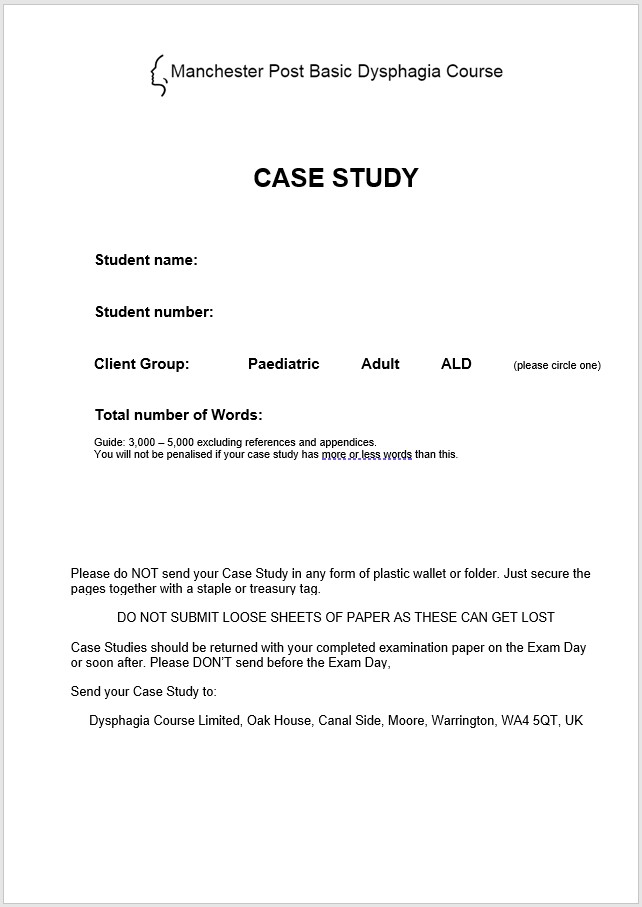Students are required to submit a Case Study pertaining to the client group of their choice (Adult, Paediatric or ALD).
The Case Study should be a detailed account of the student’s holistic assessment and management of a dysphagic individual demonstrating the practical application of their theoretical knowledge in a clinical situation.
The Case Study must be based on a “bedside” assessment and management. Whilst you may refer to other assessments such as videofluoroscopy, FEES or blue dye test you must base your case study on “bedside” assessment and management.
As a guide to what is required, the Case Study should be between 3,000 and 5,000 words plus references and appendices. You will not be penalised if your word count is more or less than this.
After clicking the link above, look for case-study-cover.doc in your downloads folder.
The following headings must be included in your Case Study:
1. Biographical information.
2. Previous pertinent medical history.
3. Previous involvement from a dysphagia practitioner or Supervisor.
It is important to summarise any previous pertinent dysphagia management that was undertaken by another dysphagia practitioner so that your involvement remains the focus of the Case Study.
4. Current medical history and reason for referral for swallowing assessment.
5. Hypothesis.
6. Assessment (observational, functional, objective).
Your completed assessment forms should be included in the appendix.
7. Anatomical, physiological and neurological dysfunction
as it relates to your assessment.
8. Therapy, intervention, management.
- You should explain the reasons for your intervention. Your intervention should not be solely texture modification. Discuss the strategies and exercises you have advised and explain how these relate to your assessment. Include the exercises in the appendix.
- If you are unable to prescribe exercises for any reason e.g., owing to lack of cognition on behalf of the dysphagic individual, then you MUST describe what exercises you would have undertaken to address dysfunction observed in the oro-motor examination and clinical signs of dysphagia observed in your assessment when the individual had oral intake. This showcases your knowledge.
9. Prognostic indicators.
10. Probable future management.
11. References.
12. Appendices.
The appendices should be used for detailed information that has been referred to and summarized in the Case Study. Only directly relevant items should be included in the appendices and these should be as brief as possible. Appropriate items may include copies of assessment forms, patient instructions, data tables, etc. No marks are awarded for the appendices. Their purpose is simply to assist the reader.
Confidentiality must be maintained throughout the body of the text and all appendices. All details of the patient, staff and Trust must be deleted.
All aspects of the Case Study must comply with professional guidelines on consent.
Plagiarism may take a number of forms, but essentially means presenting other people’s work as if it were your own. More subtle plagiarism may involve ‘lifting’ sentences or paragraphs from sources; slightly re-arranging this and intercalating it with one’s own work. There is absolutely nothing wrong with using quotes to augment your work providing they are attributed. The quotations should be clearly identified as such, and the author and source indicated. The same applies to diagrams and figures that you may wish to include in your work. If you have copied from another source, then you must reference that correctly.
If you are unable to complete your Case Study because you are no longer in contact with the client, hypothesise what your intervention, management and treatment may have been.
The Case Study should be completed by the Examination Day and ideally sent to us with the completed exam paper by the supervisor/invigilator on the Examination Day (or can be sent by the student separately on or shortly after the Examination Day).
Please do NOT send your Case Study in any form of plastic wallet or folder. Just secure the pages together with a staple or treasury tag. Do not send loose sheets of paper as these can get lost.
The address to send the Case Study to is Dysphagia Course Limited, Oak House, Canal Side, Moore, Warrington, WA4 5QT, UK. We will confirm receipt of the Case Study by email to the student. Please note that Case Studies will not be returned to the student.
Exam papers and Case Studies will be marked by the Tutors first. A sample is then passed to the External Examiner for checking. Only after the sample has been double-checked by the External Examiner will results by issued to students by email.
We cannot give a specific date by when results will be issued. It usually takes at least two months to issue results.
If a Case Study is not of an adequate standard to pass, Tutors will provide feedback by email so students can improve their Case Study and resubmit it.
If you need clarification on any of the above please contact us.
